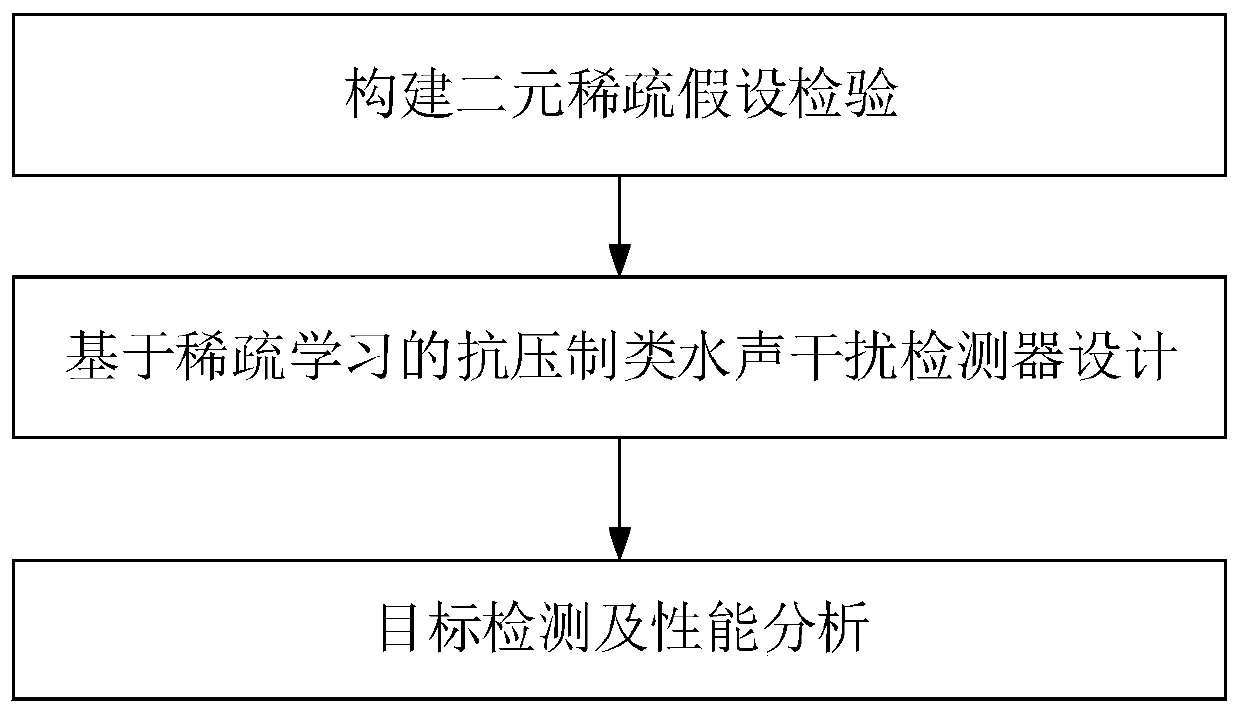Multi-channel adaptive detection method and system for resisting suppression-type hydroacoustic interference
An adaptive detection, multi-channel technology, applied in the direction of radio wave measurement system, measurement device, sound wave re-radiation, etc., can solve the problem that can not meet the practical application of motion sonar, does not have the ability to accurately estimate the interference target, ignore the underwater Data sparsity and other issues
- Summary
- Abstract
- Description
- Claims
- Application Information
AI Technical Summary
Problems solved by technology
Method used
Image
Examples
Embodiment 1
[0067] like figure 1 As shown, Embodiment 1 of the present invention provides a multi-channel adaptive detection method for suppressing underwater acoustic interference, the method comprising:
[0068] 1. Construct a binary sparse hypothesis test
[0069] Assuming that the interference data to be detected is received by a linear array composed of N array elements, the detection of suppressing interference targets can be summarized as the following binary hypothesis test:
[0070]
[0071] where H 0 and H 1 Represents the untargeted hypothesis and the targeted hypothesis, respectively; z k , k=1,..., K represents the received K statistically independent data to be detected (also known as main data), which is an N×1-dimensional complex vector, subject to zero-mean, N-dimensional complex Gaussian distribution; M 0 and M 1 Respectively represent H 0 and H 1 Assuming the N×N dimensional interference covariance matrix:
[0072]
[0073]
[0074] In the above formula...
Embodiment 2
[0139] Embodiment 2 of the present invention provides a multi-channel self-adaptive detection system for suppressing underwater acoustic interference, and the system includes:
[0140] The data acquisition module is used to acquire the data to be detected that is subject to independent and identical distribution received by the multi-element linear array;
[0141] A parameter estimation module for estimating the parameters of pre-built binary sparse hypothesis tests using an iterative minimization sparse learning algorithm;
[0142] An anti-suppressive underwater acoustic interference detector based on sparse learning is used to calculate detection statistics based on estimated parameters and complete adaptive detection of targets.
Embodiment 3
[0144] Embodiment 3 of the present invention provides a computer device, including a memory, a processor, and a computer program stored on the memory and operable on the processor. When the processor executes the computer program, the computer program is implemented. Example 1 method.
PUM
 Login to View More
Login to View More Abstract
Description
Claims
Application Information
 Login to View More
Login to View More - R&D
- Intellectual Property
- Life Sciences
- Materials
- Tech Scout
- Unparalleled Data Quality
- Higher Quality Content
- 60% Fewer Hallucinations
Browse by: Latest US Patents, China's latest patents, Technical Efficacy Thesaurus, Application Domain, Technology Topic, Popular Technical Reports.
© 2025 PatSnap. All rights reserved.Legal|Privacy policy|Modern Slavery Act Transparency Statement|Sitemap|About US| Contact US: help@patsnap.com



